When I speak of trapping rats, I mean Muskrats. In today’s market (2011), there is a very high demand for those little critters fur. The Chinese garment makers are clamoring for more and more furs so they can make coats/scarfs/hats/liners etc. to sell to the Russian consumers. You see, it is very cold in Russia and fur is by far the best natural insulator. The Russians love fur garments. Their economy was down for several years due mostly to the low price being given for their crude oil. But now that has all turned around. Oil prices are up, they are getting their feet firmly planted on the ground again and so they have spending money and a high desire to cloth themselves in warm over coats and the like.
The Chinese let their inventory of garments get very low because they were not selling “last years” clothing at a rate fast enough for them to make more. They also were not offering very high prices for muskrat pelts here in the U.S. and so trappers virtually quite catching them. Suddenly, we are faced with a very high demand and few goods on stretchers or in freezers to offer for sale. Trappers are now coming out of the woodwork to catch them and reap the benefits of this high demand/high price item.
Brother Bob, Nephew Brek and I have not let the market determine whether we were going to catch rats or not. We are. It’s on the price end that has determined whether we freeze our catch or sell. Two seasons ago we froze 700 pelts because the price being offered was only about $2.80 for each pelt. We felt we needed another dollar for each pelt and the buyers were not willing to give us that much. The next year we caught 900 rats, and the price was up in the high $3 range and we pooled the two years catches together and took them to Caldwell Idaho and sold them for $3.89 average. That was a good check! This year the demand was even higher and we caught 991 rats and they sold locally for $7 each! N0w THAT was a good check!
I’ve already told you about all of this. What I intended to do with this story was to show you some of the things that happen out on the trap line. A trapper always wants to catch a rat in every trap, every day. But in reality, what our individual goal is, is to make our expenditures each day. Mostly it’s the price of our fuel to get to the trapping area and back that is the biggest driver. So with my vehicle, I figure I need to catch at least 3 rats p/day to get my gas money back. Since I am retired, what else am I going to do with my time? So I don’t count that as spending anything. Then there is a sandwich or two, some water and wear and tear on the vehicles. 3 rats at the usual $3 price and we have our expenses pretty much covered.
Bob and I usually try and get 100 traps out each on our individual lines. You would think it would be easy to catch 3 rats with 100 traps out. But it doesn’t always work that way. When you first set the line, you only have part of the traps out. It generally takes me 3 days to get my 100 traps set. By the third day, the first 30 or so traps are “playing out” and the rats have caught onto the trap locations. They are not dumb little critters. I am always moving traps, while Bob leaves his set and waiting for the “run”.
I like to use mostly Conibear type traps. These form a square when they are set and so they fit nicely into runs and over the mouths of dens. When the rat swims down the run or comes out of or goes into the den, it gets caught. Like this one.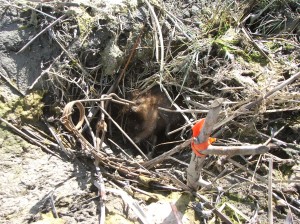
Of course that is if the trap fires properly and no malfunctions occur. I have learned over the past four or five trapping seasons that these seemingly faultless traps are all but faultless. You would think that there would be no way they could fail. But believe me, they have ways of “almost” catching a rat. And when they do, there is one very smart rat out there teaching the others what to be aware of and how to stay safe.
Case in point: The Conibear type traps have wires that hang down into the opening of the trap when it is set. The rat moves the wires out of the way as they make their way through the trap opening. This movement of the wires, causes the Dog of the trap to release the jaws and the jaws close on the unsuspecting rat. But on occasion, the wires can get caught on the closing jaw. Even the Dog itself can catch on the jaw. These things are very frustrating to me. Check this one out.
How about a more frustrating miss when the dog itself catches on the closing jaw. I never in all the world expected to see this happen, but here is proof.
Even the conventional trap like the Victor Stop Loss can have it’s issues. When trapping in sticky clay like muddy areas, always make sure you clean any mud that might get on the trap off, before re-setting it, or you could come to check the trap tomorrow and find a scene like this one.
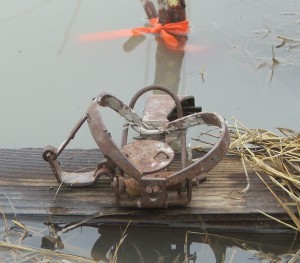 You can see the trap has been sprung, the jaws started to close and because I had not cleaned off the mud on the spring side of the trap, the mud held the jaws from allowing the spring to finish closing the jaws on the unsuspecting rats leg.
You can see the trap has been sprung, the jaws started to close and because I had not cleaned off the mud on the spring side of the trap, the mud held the jaws from allowing the spring to finish closing the jaws on the unsuspecting rats leg.
And then there are the smart rats. They know the trap is right there and to avoid stepping into the trap. And THEN to add INSULT TO INJURY, they will leave a little note for you saying, “I know you are here mr. trapper, but take this and learn a thing or two about trapping. I am on to you and your ways. You might as well leave us alone, I am teaching all of the other rats in this swamp about how to avoid going home with you”!
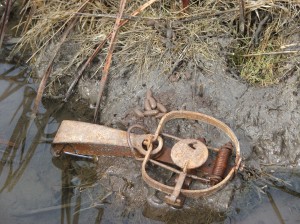 Notice the little poop droppings near the trap! Smart ass rat.
Notice the little poop droppings near the trap! Smart ass rat.
But not all of them learn to avoid getting in the traps. I like to use what is called Colony traps. They are wire boxes with one way doors on each end. The rats swim into the trap and can’t get out. They call them colony traps because of the fact that you can catch multiple rats in the same trap over night. The rats can’t get out, and they drown.
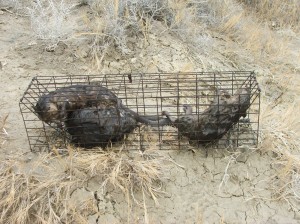 There is the gas money for today’s trip to the swamp.
There is the gas money for today’s trip to the swamp.
When everything is said and done the end of the day can look like this. Bob, Brek and I pile up the days catch and begin our job of skinning, fleshing and stretching.
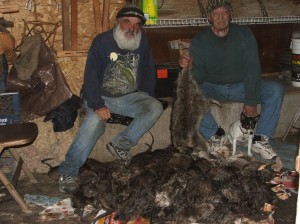 That is 58 rats and one raccoon for one days catch between the two of us. Not bad for one day.
That is 58 rats and one raccoon for one days catch between the two of us. Not bad for one day.
Now maybe you are wondering how in the world can a person keep track of 100 traps so as to be able to check them after setting them. Believe me it would be impossible for me to keep track of 100 traps. Heck I have a tough enough time remembering where 2 traps are yet alone 100 or so. So, we use flagging tape to mark the general area as to where the trap is set.
 And then I create a general map of the entire line of traps, so I know where to go to find the next flag. Often times I will have two to five traps within a short distance of each other. And then I might travel 50 to 100 yards down the stream or out into the swamp to set another series of traps. My map keeps me on track and hints on the map keep me knowing I am in the right place on the map.
And then I create a general map of the entire line of traps, so I know where to go to find the next flag. Often times I will have two to five traps within a short distance of each other. And then I might travel 50 to 100 yards down the stream or out into the swamp to set another series of traps. My map keeps me on track and hints on the map keep me knowing I am in the right place on the map.
 Well, now you know how I do it and keep track of everything I need to in order to not lose traps by not knowing where they are in the swamp. Of course there are always the racoons, hawks and eagles that come along and take your rat, trap and everything off and away. You can’t help but loose a trap or two during the season. That is all part of the whole process.
Well, now you know how I do it and keep track of everything I need to in order to not lose traps by not knowing where they are in the swamp. Of course there are always the racoons, hawks and eagles that come along and take your rat, trap and everything off and away. You can’t help but loose a trap or two during the season. That is all part of the whole process.
Enjoy your own trapping. It isn’t always about the catching that pays the biggest dividends, but catching is what you are trying to do.
Bears Butt
Aug. 2011


 Utah Fishing Reports
Utah Fishing Reports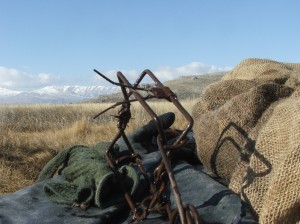
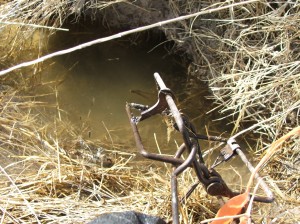

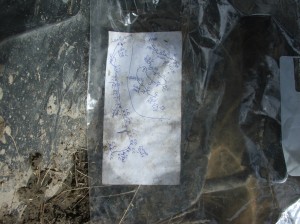
Leave a Reply